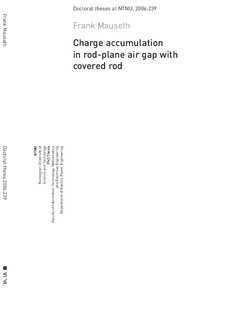| dc.contributor.advisor | Nysveen, Arne | nb_NO |
| dc.contributor.advisor | Ildstad, Erling | nb_NO |
| dc.contributor.author | Mauseth, Frank | nb_NO |
| dc.date.accessioned | 2014-12-19T13:29:23Z | |
| dc.date.available | 2014-12-19T13:29:23Z | |
| dc.date.created | 2007-04-12 | nb_NO |
| dc.date.issued | 2007 | nb_NO |
| dc.identifier | 122274 | nb_NO |
| dc.identifier.isbn | 82-471-8260-2 | nb_NO |
| dc.identifier.uri | http://hdl.handle.net/11250/249697 | |
| dc.description.abstract | The focus of this work has been on hybrid insulation in inhomogeneous electric fields under lightning impulse voltage stress. The principal idea behind hybrid insulation is the intentional use of surface charges to re-distribute the electric field within an insulation system. This allows a significant part of the electric stress to be transferred from the dielectric weaker gas to the dielectric stronger solid insulation thus increasing the total electric strength of the insulation system.
The concept has been theoretically and experimentally addressed by means of a hemispheric rod covered with a layer of solid insulation. Discharge activity and surface charge accumulation have been studied in an air gap by measuring the voltage and discharge current and recording the discharge activity using a high-speed digital camera. New methods have been introduced and evaluated for the evaluation of surface charge measurements.
The experiments found that the increase in positive inception voltage was considerable compared to uncovered rods. This increase varied from 35% up to 100% depending on the electrode distance. The increase in breakdown strength is higher than the increase in inception voltage and dependent on the covered length of the rod. During the application of a lightning impulse, the discharge activity spreads upwards along the rod and out into the air gap. Positive discharges form numerous branches and bridge the air gap in most cases. Negative discharges are more diffuse, less light intensive and only form a few branches around the tip of the rod where the electric field is the strongest. Discharge activity along the insulating surface has been observed where the background field is lower than the critical electric field strength. Visible discharge activity is observed where the background field is higher than 2.3 kV/mm and 2.5 kV/mm for positive and negative impulses respectively.
During the application of lightning impulses, discharge activity starts in the air gap around the tip where the electric field is highest and spreads upwards along the rod. As expected, negative charges accumulate on the surface in the case of positive impulse voltage and vice versa. However, after more powerful discharges during negative impulse voltage application, surface charges of both polarities have been observed.
Accumulated surface charges decay exponentially with a time constant τ varying from micro-seconds to hours depending on the material properties of the solid insulation. The dominating relaxation mechanism is found to be conduction through the solid insulation.
Improved methods to calculate surface charges based on probe response for a 2D axial symmetric case have been developed and evaluated. The method that is best suited for this purpose is the λ-method with truncated singular value decomposition (TSVD) as regularization.
Surface charge calculations show that the accumulated surface charges for the used configuration typically have a maximum value of 0.6 to 1.5 µC/m² and 0.4 to 1 µC/m² after positive and negative impulses respectively. The surface charge density in the areas with the highest discharge activity is relatively uniform. Further upwards along the rod, the surface charge density is reduced relatively fast towards zero, and in some cases, it changes polarity before approaching zero. | nb_NO |
| dc.language | eng | nb_NO |
| dc.publisher | Fakultet for informasjonsteknologi, matematikk og elektroteknikk | nb_NO |
| dc.relation.ispartofseries | Doktoravhandlinger ved NTNU, 1503-8181; 2006:239 | nb_NO |
| dc.subject | Hybrid Insulation Charge Accumulation Measurement | en_GB |
| dc.subject | TECHNOLOGY: Electrical engineering, electronics and photonics: Electric power engineering | en_GB |
| dc.title | Charge accumulation in rod-plane air gap with covered rod | nb_NO |
| dc.type | Doctoral thesis | nb_NO |
| dc.source.pagenumber | 122 | nb_NO |
| dc.contributor.department | Norges teknisk-naturvitenskapelige universitet, Fakultet for informasjonsteknologi, matematikk og elektroteknikk | nb_NO |
| dc.description.degree | PhD i elektronteknikk | nb_NO |
| dc.description.degree | PhD in Electrical Engineering | en_GB |
